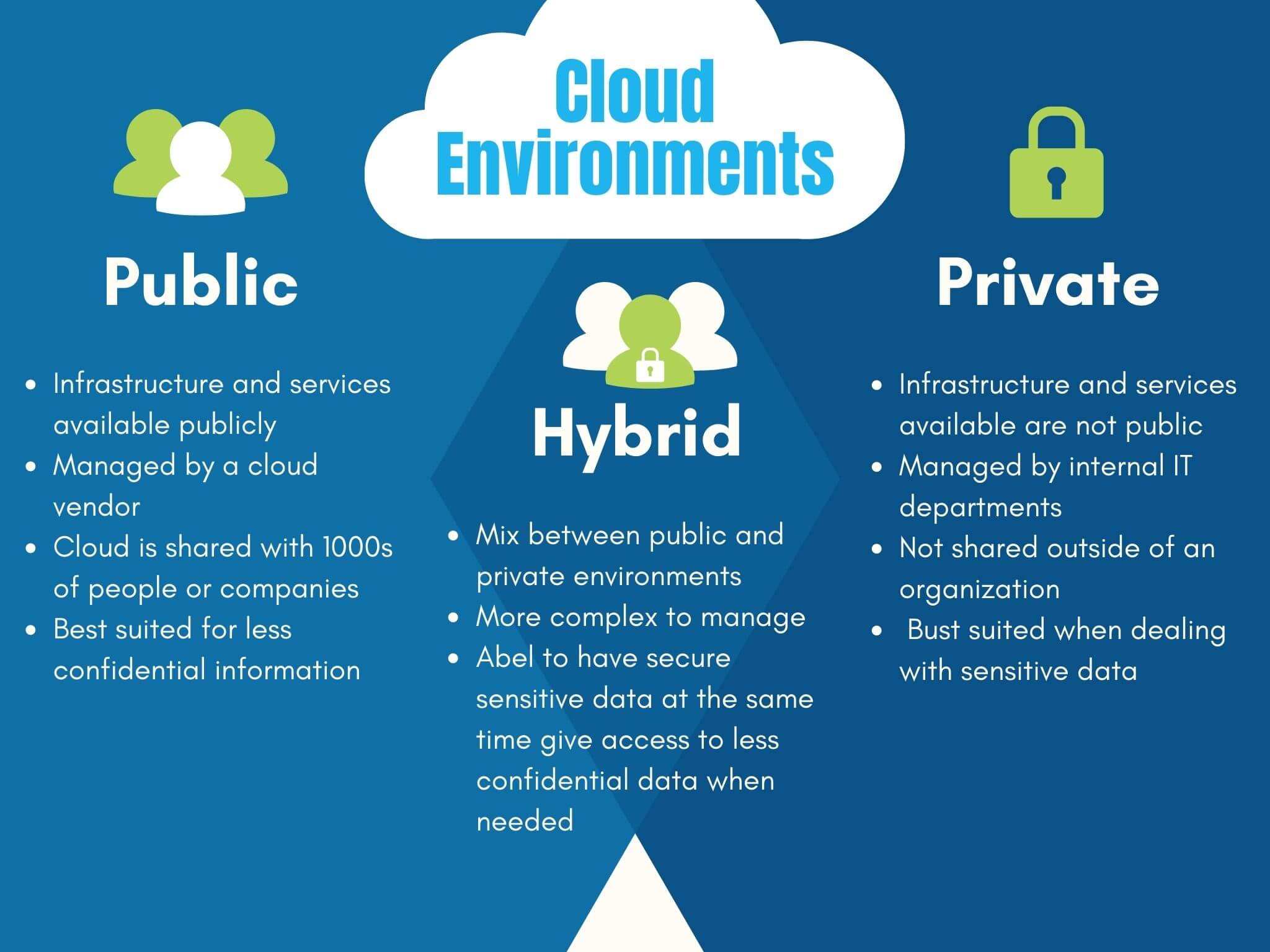
In the last few years, cloud computing has become an extremely popular option to help organizations cut operational costs. Yet, believe it or not, it’s been around for decades. The concept of cloud computing was first introduced in the 1960s as a way to deliver computing resources through a global network. Now it’s being picked up everywhere. In fact, by the end of 2020, Forbes predicts:
%
Enterprise Infrastructure Will Be Cloud-Based
With cloud computing becoming omnipresent in our digital world, it represents the forefront of how enterprises are making the move to digital transformation.
What is Cloud Computing?
Cloud computing is a way to deliver computer services over a network, typically the Internet. On an enterprise level cloud computing services include storage, servers, software and analytics. For consumers, cloud computing services can include email, data backup, streaming services and photo storage.
Prior to the cloud, users could store data and software only on hard drives and servers, causing limitations depending on device and storage. Now with the cloud, users can have wide access to applications and services without worrying about restrictions, and enterprises can easily scale and cut down on hardware instead of depending on on-premise servers and data storage devices.
Types of Cloud Computing
Public Cloud
A public cloud is where a cloud service provider makes infrastructure and services available publicly over the Internet. Meaning hardware, storage, and network devices are shared.
Public clouds are used on an individual basis or by organizations that reserve space on part of the public cloud network. The cloud can be shared with thousands of people. Gmail is a fitting example of a public cloud service. You have a private password to log into your specific portion of the cloud, but the hardware in which your information is stored on is shared by thousands of people.
Benefits of Public Cloud
Cost Effective
Pricing is flexible and based on different offerings from the cloud provider. There is also cost savings from not having to maintain any of the infrastructure.
Easy to Set Up
Organizations can access the public cloud in just as little as a few hours through the Internet.
No Maintenance
The service provider of the public cloud will perform all maintenance and updates, freeing up IT staff to handle the important stuff.
Scalable
If at any time an organization requires more space, scalability is always available on demand.
Private Cloud
Private clouds are very secure and are by the organizations internal IT, which can be on-premise or through a co-location provider. Private clouds are private! Meaning that they are a very secure infrastructure that only the allowed organization has access to and is not shared with anyone and certainly not available to the public.
Any organization who has sensitive customer data or needs to adhere to guidelines for data controls like PPI use a private cloud.
Private cloud providers include companies like VMWare, Cisco Systems, Microsoft and many more.
Benefits of Private Cloud
Customizable
Organizations can build their private cloud efficiently to meet their requirements for storage and computing.
Performance
Since the private cloud is deployed within the company’s firewall of the intranet, this ensures efficient and robust network performance.
Compliance
Since companies have full control and configuration over the private cloud, they’re able to adapt to any compliance regulations that are required.
Secure
As compared to the public cloud, private cloud is substantially more secure. Data is safely stored and secured on private servers that has zero public access.
Hybrid Cloud
Hybrid cloud is a combination of a public and private cloud that leverage the advantages of both cloud environments to maximize the user’s needs and requirements. This means, creating a parallel environment where applications move seamlessly between the public and private cloud.
This is a more complex environment as the organization will have to manage multiple platforms and figure out where the best place is to store their data.
Hybrid could need to secure customer data on-premise but also need to allow customers to interact with an application offered publicly.
Benefits of Hybrid Cloud
Business Continuity and Disaster Recovery
In the event of a failure or disaster, should something happen to your private environment, a public cloud can be activated as a redundancy measure to ensure business continuity. Another advantage is backup and recovery updates, which are completely taken care of by the cloud service providers themselves. This also frees IT to not have to worry about performing backups to prioritize other critical tasks.
Flexibility
Having the availability to both private cloud and public cloud means organizations can figure out how to best store and optimize their infrastructure and applications with the freedom to change them at any time.
Cloud Bursting
When a private cloud is reaching capacity limitations from a sudden uptick of demand, for example from application deployments, cloud bursting can be implemented which allows a public cloud to carry on further deployments.
Risk Management
A hybrid cloud environment is the perfect platform to help manage risk and enhance security. Sensitive data can be kept securely on a private cloud, while other applications or data can be kept on a public cloud. Plus, with hybrid cloud, you can test your workloads privately before actually moving them to the public cloud to ensure a smooth transition.

Types of Cloud Services
Cloud services are usually provided by cloud computing providers and are broken down into three separate groups:
1. Software-as-a-Service (SaaS)
SaaS is cloud-based software and applications that can be accessed by browser, desktop client or API, that is usually provided through a pay-as-you-go model or on-demand on a per-user basis.
Examples of SaaS would include web-based email such as Gmail, Microsoft Office 365 and Salesforce. Because SaaS applications run directly through a web browser and don’t require downloads or installations, IT teams don’t have to spend time installing, managing and upgrading software on every individual company computer.
Since SaaS is handled by the third-party service provider, customization is limited. This can affect different aspects of the software, including data security and performance.
2. Infrastructure-as-a-Service (IaaS)
IaaS is on-demand operating systems to servers and storage where users connect to it all through IP-based connectivity as part of an on-demand service.
There are some limitations to the IaaS model though. You may have to provide your employees with additional resources or training to learn how to effectively manage the infrastructure, and, though clients have more control, security threats from the host or other virtual machines still exist.
Popular examples of the IaaS system are Microsoft Azure and Amazon Web Services. Note with IaaS, the business manages applications, data, runtime, operating system and middleware.
3. Platform-as-a-Service (PaaS)
Considered the most complex of the three layers, PaaS is an on-demand platform that gives users the ability to develop, launch and manage applications without having to deal with the infrastructure required for building those applications.
Like SaaS and IaaS, PaaS has data security concerns, as well as limitations when it comes to specific legacy apps and services that may require customization or configuration on the client’s end. With PaaS, an enterprise manages applications and data
Examples of PaaS are DigitalOcean, Rackspace and Google Compute Engine.

Implementing Cloud Computing
With more companies moving towards digital transformation and “cloud-first” start-ups taking over, enterprises completely using on-premise or legacy systems are seeking cloud solutions. While moving to the cloud benefits enterprises in the long run, in the short-term a cloud migration means an in-depth evaluation of the applications you’re on, what systems you need to keep running and where to being when moving to a cloud infrastructure.
Make sure when you looking for a cloud provider to ask the right questions. Here are 31 Questions to Ask Your ECM Cloud Solution Provider, to ensure you’ve covered the most important topics, including security, connectivity, maintenance and more.
